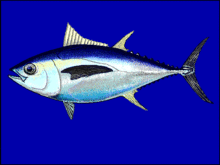| Revision as of 15:04, 8 December 2010 editLfstevens (talk | contribs)Extended confirmed users68,559 edits ce← Previous edit | Revision as of 22:27, 8 December 2010 edit undoMagioladitis (talk | contribs)Extended confirmed users, Rollbackers908,576 editsm fixNext edit → | ||
| Line 1: | Line 1: | ||
| {{refimprove|date=December |
{{refimprove|date=December 2010}} | ||
| {{Taxobox | {{Taxobox | ||
| | name = Bigeye tuna | | name = Bigeye tuna | ||
Revision as of 22:27, 8 December 2010
| This article needs additional citations for verification. Please help improve this article by adding citations to reliable sources. Unsourced material may be challenged and removed. Find sources: "Bigeye tuna" – news · newspapers · books · scholar · JSTOR (December 2010) (Learn how and when to remove this message) |
| Bigeye tuna | |
|---|---|

| |
| Conservation status | |
 Vulnerable (IUCN 2.3) | |
| Scientific classification | |
| Kingdom: | Animalia |
| Phylum: | Chordata |
| Class: | Actinopterygii |
| Order: | Perciformes |
| Family: | Scombridae |
| Genus: | Thunnus |
| Species: | T. obesus |
| Binomial name | |
| Thunnus obesus (Lowe, 1839) | |
The bigeye tuna, Thunnus obesus, is an important food fish and prized recreational game fish. It is a true tuna of the genus Thunnus, belonging to the wider mackerel family Scombridae.
In Hawaiian, it is one of two species known as ʻahi; the other is yellowfin tuna.
Range and habitat
Bigeye tuna are found in the open waters of all tropical and temperate oceans, but not the Mediterranean Sea.
Anatomy
Bigeye tuna vary up to 250 centimetres (98 in) in length. Its maximum weight probably exceeds 400 pounds (180 kg), with the all-tackle angling record standing at 392 pounds (178 kg). They are large, deep-bodied, streamlined fish with large heads and eyes. The pectoral fins are very long, reaching back as far as the second dorsal fin. They display 13 or 14 dorsal spines.
Physiology
The bigeye forages in cold and oxygen-poor subsurface waters. Their blood extracts oxygen efficiently even in oxygen-poor conditions. Their vision functions well in low light conditions. The heart has an unusual ability to function effectively while foraging in cold subsurface water. Nonetheless, they must periodically return to warmer surface waters to warm up.
Life history
Longer-lived than the closely related yellowfin tuna, the bigeye has a lifespan of up to 12 years, with sexual maturity at age four. Spawning takes place in June and July in the northwestern tropical Atlantic, and in January and February in the Gulf of Guinea, which is the only known Atlantic nursery area.
Satellite tagging showed that bigeye tuna often spend prolonged periods diving deep below the surface during the daytime, sometimes reaching 500 metres (1,600 ft). Bigeye have been tracked entering water as cold as 5 °C (41 °F). These movements are thought to be in response to vertical migrations of prey organisms in the deep scattering layer.
Feeding
Feed items include both epipelagic and mesopelagic species, with deep diving behaviour during the day thought to be related to the seeking of prey.
Fishery
Bigeye tuna are amongst the tuna species most threatened by overfishing. Juvenile bigeye tuna associate closely with floating objects such as logs, buoys and other flotsam, which makes them susceptible to purse seine fishing in conjunction with man-made fish aggregation devices. The removal of large numbers of juvenile bigeye, before they reach breeding age, is a major concern to fisheries managers, scientists and sport fishermen. Most seafood sustainability guides encourage consumption of other types of tuna.
For the first time ever, NOAA closed the western and central Pacific bigeye fishery to the Hawaiʻi-based longline fishing fleet for the final three days of 2009, having reached the internationally-agreed catch limit of 3,673 metric tons (3,615 long tons). This limit is 30% lower than that of earlier years and will also apply to 2010. The ban does not apply to yellowfin tuna and other fishes or bigeye in the eastern Pacific.
In 2010, Greenpeace International has added the bigeye tuna to its seafood red list. "The Greenpeace International seafood red list is a list of fish that are commonly sold in supermarkets around the world, and which have a very high risk of being sourced from unsustainable fisheries."
References
- http://www.hawaii-seafood.org/yellowfin.html?ref=Hawaii
- "Bigeye tuna off limits to longline fleets for last three days of 2009". Associated Press. December 21, 2009. Retrieved December 2009.
{{cite web}}: Check date values in:|accessdate=(help) - Greenpeace International Seafood Red list
- Template:IUCN2006 Listed as Vulnerable (VU A1bd v2.3)
- "Thunnus obesus". Integrated Taxonomic Information System. Retrieved 18 April 2006.
- Froese, Rainer; Pauly, Daniel (eds.). "Thunnus obesus". FishBase. January 2006 version.
- Tony Ayling & Geoffrey Cox, Collins Guide to the Sea Fishes of New Zealand, (William Collins Publishers Ltd, Auckland, New Zealand 1982) ISBN 0-00-216987-8
- Clover, Charles. 2004. The End of the Line: How overfishing is changing the world and what we eat. Ebury Press, London. ISBN 0-09-189780-7
- Richard W. Brill1, Keith A. Bigelow, Michael K. Musyl, Kerstin A. Fritsches, Eric J. Warrant,
'BIGEYE TUNA (THUNNUS OBESUS) BEHAVIOR AND PHYSIOLOGY AND THEIR RELEVANCE TO STOCK ASSESSMENTS AND FISHERY BIOLOGY'. ICCAT, 2005. http://www.soest.hawaii.edu/pfrp/reprints/iccat_bigeye.pdf
- ScienceDaily (Dec. 3, 2007), 'Turning A Blind Eye To Bigeye Tuna'. http://www.sciencedaily.com/releases/2007/11/071126144222.htm
- National Marine Fisheries Service, 'Atlantic Bigeye Tuna'. http://www.nmfs.noaa.gov/habitat/habitatprotection/profile/hms/atlantic_bigeye_tunahome.htm
| Principal commercial fishery species groups | ||||||||||||||||||||
|---|---|---|---|---|---|---|---|---|---|---|---|---|---|---|---|---|---|---|---|---|
| Wild |
|    | ||||||||||||||||||
| Farmed | ||||||||||||||||||||